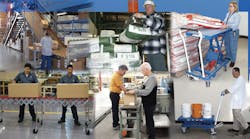Working in the ‘Power Zone’ (and Other Safe Material Handling Tips for Retailers)
Retailers can reduce the number of strains and sprains in the workplace by using transport and lift-assist devices and modifying work practices to enable employees to work within their “power zone,” NIOSH explains in a new safety publication.
In “Ergonomic Solutions for Retailers,” NIOSH highlights a number of strategies that grocery stores and other retail establishments can make to protect workers from musculoskeletal injuries when moving materials from the delivery truck to the sales floor.
“Data has shown us that not only do musculoskeletal injuries result in time away from work across all industry sectors, but data shows that they affect workers in the wholesale and retail trade at a higher rate,” NIOSH Director Dr. John Howard said. “This new resource is an invaluable tool for workers in this industry to help decrease injuries and increase productivity.”
While NIOSH noted that the new publication focuses on the grocery sector, the agency added that “the easy-to-read format can be adapted to other scenarios, including for those working in warehouse and storage facilities.”
“The technology presented may also support a retailer’s growing Internet sales that depend on moving large quantities of merchandise often with fewer employees,” NIOSH said.
In the publication, NIOSH outlines the steps in an action plan for reducing workplace injuries related to manual material handling:
- Look for clues – Review OSHA 300 logs and other written records; observe work activities; talk to workers; and use assessment tools such as the NIOSH Manual Material Handling Checklist.
- Prioritize jobs for improvements – Decide which tasks to improve first, based on the frequency and severity of risk factors and complaints, among other factors.
- Make improvements – NIOSH notes that the goal of ergonomic improvements “is to improve the fit between the demands of work tasks and the capabilities of your workers.”
- Follow up – Separately evaluate each improvement for effectiveness. Has the improvement reduced or eliminated fatigue, discomfort, symptoms and/or injuries, as well as most or all of the risk factors?
The NIOSH publication includes three sections on improvement options:
- Section 1 – Easier ways to manually lift, lower, fill or empty containers.
- Section 2 – Easier ways to manually carry containers.
- Section 3 – Alternatives to manual handling of individual containers.
According to the Bureau of Labor Statistics, musculoskeletal injuries accounted for 34 percent of all occupational injury and illness cases in 2012. Laborers and freight, stock and material movers experience the highest number of overexertion injuries. The injuries often involve strains and sprains to the lower back, shoulders and upper limbs.
